#really makes every instance of physical touch between them that much more loaded and coded
Explore tagged Tumblr posts
Text

the kiss ask in question (viral post if you're an archie microblogger)
this is an esoteric one sorry to my followers who arent into the riverdale abuse cycles niche. but wrt the hirarchie kiss ask going around i do think its interesting that it goes without saying for everyone that hiram would kiss archie. and like yeah of course because hes obsessed with him and a monster and a loser creep and the whole hirarchie thing is generally a desire to explore archie's feelings of being taken advantage of by someone sexy and horrible. BUT i would like to pose a scenario where at some point, early in their partnership and still reeling from the black hood hurting fred and ms. grundy, archie goes in for a kiss. and hiram does not do anything at all but just knows that about archie for the rest of the show. that aould also be fucked up and interesting right
#oh that's an excruciating answer tbh. love it#really makes every instance of physical touch between them that much more loaded and coded#really enriches the whole carrie episode subplot with hiram pushing boundaries to the point of making fred jealous#it makes archie's choice to accept hiram refusing to ransom him from nick st clair seem even more self-effacing. self-hating even#woof. thanks for that#hirarchie#hiramaissance#(for blacklists)
69 notes
·
View notes
Text
New Features, Lightning Round!
There's been a lot of updates over the past few weeks, and I have been a little too busy implementing them to take the time to upload my progress, so here I will quickly try to show off these features and credit my resources!
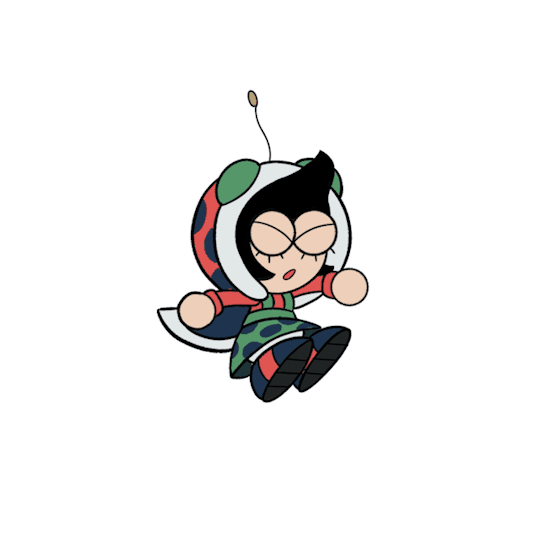
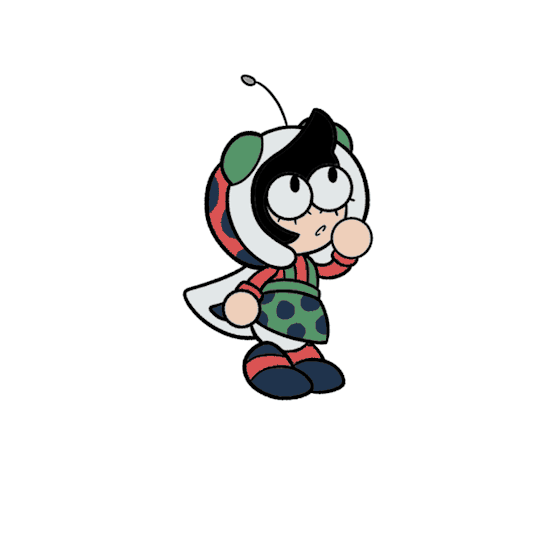
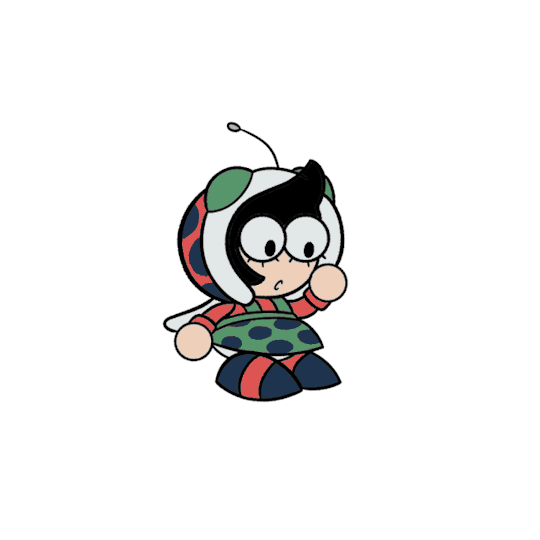
New Animations and Player States So I actually had to totally rewrite the player code to add these new animations and a couple of new states involving getting damaged, dying, and winning the game.
I mostly used the logic from this Godot tutorial by Nathan Lovato in GMS2 which helped me to really break down the character into good chunks. It was tricky to work out the kinks when I started but it worked just as well now and made the workflow with these other new features a lot easier. I also used a lot more functions() to be able to speed things up, since physics would need to be written in every state.
Essentially, these new states work like this:
Touch something bad? Damage State. Damage State? Check if they still have health. (tutorial on invincibility frames by HeartBeast) No health? Enter death state. Death state? Transition to title Game Over room.
And the winning state will simply transition you to the "winning room" as soon as you touch the winning item. And the looking-up and looking-down animations are used in the idle state if the camera detects that that is what the player is inputting.
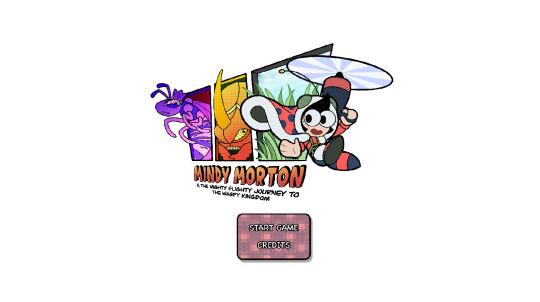
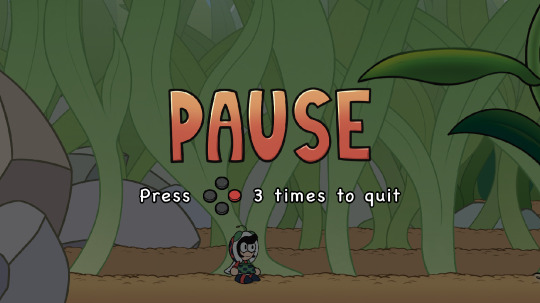
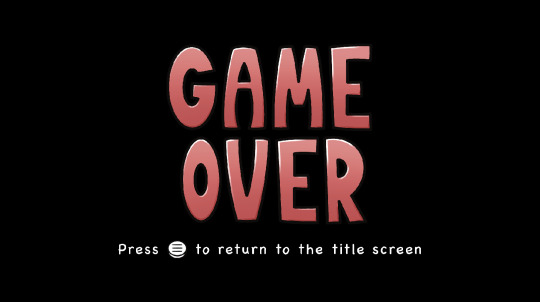
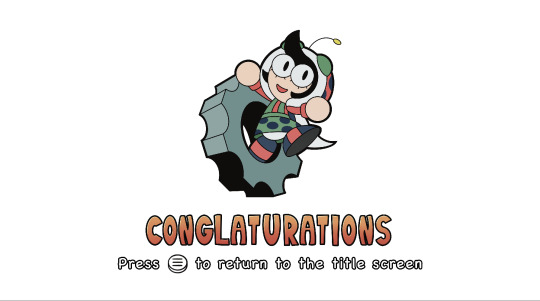
Title Screen, Pause Menu, Game Over, and Winning Screen So to make these work, the first thing I had to do was actually decouple my camera from my player. Coupling is what happens when you write the code of two objects in such a way that they can't run without each other being present. Decoupling was difficult for me since I did not understand the key difference between calling an instance and calling an object. Basically, an object includes all instances of that object, but an instance is only one specific object that's already loaded.
However, once I did, it was fairly easy to move the camera around through code without a player present and create the Game Over, Title Screen, and Win Screen all on my own.
For the pause menu, I used this tutorial by Shaun Spalding and implemented some assets in the Draw event to make it feel like a proper pause menu.
I'm also just going to mention here that I used this other tutorial by Shaun Spalding to implement a transition so the game doesn't just freeze for 20 seconds while it loads the other room.
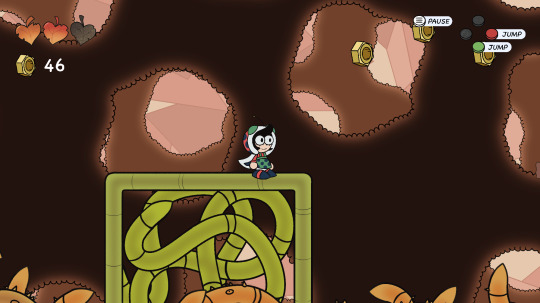
A few more assets I implemented a few more assets, mainly for UI. I actually was able to figure this out by reading documentation! It was pretty much all handled in the DrawGUI event. I also added some simple hearts and coins by using GameMaker Studio's health and score properties, which are universal throughout the project, like a global variable!
Everything past that was mostly more assets like recoloring the roots, making some more roots with the spikes on them, and then making additional backdrops for above ground and underneath the ground! I would share them all here but I intend to share a link to download the game in the next post, so keep your eye open for that!! :)
#gamedev#original character#gamemaker studio 2#animation#code#visdev#cute#character design#visual development
10 notes
·
View notes
Text
Chase Koeneke’s Top 10 Handheld Games of 2019
With the Switch in full gear and the debut of Apple Arcade, 2019 was another solid year for handheld games. Sequels to many of my favorite games were plentiful, but very few absolutely blew me away. And a few games I really loved (Slay The Spire, Return Of The Obra Dinn, Super Mega Baseball 2) were handheld ports of previous games I didn’t feel super great about adding to my list. So instead, I left this final year of the decade feeling content, and that’s perfectly OK too. So here are 10 games I liked this year, even if I didn’t love them.
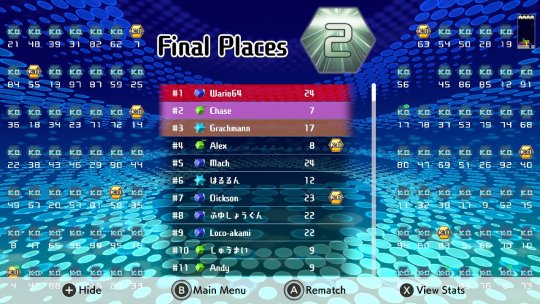
10. Tetris 99 (Switch)
I love pretty much all iterations of Tetris. From the iconic Game Boy release I would play in the car, to the Facebook-based Tetris Friends that kept me company through many boring lectures in college, to last year’s gorgeous and powerful Tetris Effect, Tetris is A-OK with me.
Battle royale games on the other hand? Not so much. Despite enjoying shooters in general, I’ve yet to play a single match of PUBG, Fortnite or Apex Legends, and I’m not itching to change that anytime soon. But I found the mechanics of the battle royale genre to translate rather brilliantly to Tetris. It’s a thin experience (even with the expansions made to the game), but it’s an addictive one. And the fact I never quite crested the mountaintop – even if I did get a second place finish to video game Santa himself, Wario64 – is one of my biggest 2019 gaming regrets.
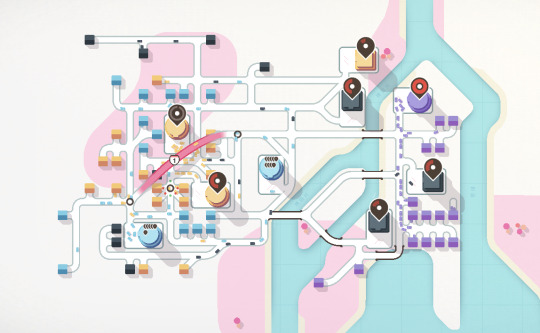
9. Mini Motorways (Apple Arcade)
Dinosaur Polo Club’s previous game, Mini Metro, made my top games of 2016 list, so it’s not surprising to see their latest game show up on this year’s list. What is a little surprising is how much of what could be said about Mini Metro can be echoed here on Mini Motorways. From my 2016 write-up:
Mini Metro wins my heart for its amazing ability to be serenely relaxing and nail-bitingly stressful simultaneously. Watching the train cars move back and forth around the sharp, minimalistic map brings a calming sense of satisfaction, but when the ever-growing amount of train stations hits critical mass, there were few experiences more harrowing this year. The basic strategy is smart and layered, preferring to let you experiment rather than tutorializing you to death up front.
You could remove the word “train” and get yourself a pretty accurate Mini Motorways review. But unfortunately, it’s not quite that simple. While I love a lot of what’s new in Mini Motorways – being able to create partial roads to better plan out cities from the start, colorful and sprightly graphics – the strategy and variety on display here actually pales to the previous game. One Mini Motorways upgrade, the traffic light, doesn’t even seem to function correctly. And the fun modifiers in Mini Metro’s different locations like Tokyo’s shinkasen are nowhere to be found here. Every city has a body of water to deal with, it’s just that some are slightly more of a pain than others. That’s not variety.
Don’t get me wrong, I love Mini Motorways and have put a lot of time into it. It’s my #9 after all. But if I had to pick just one to take up space on my phone, Mini Metro is getting that spot every time.
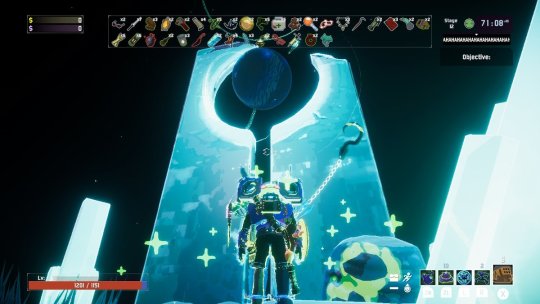
8. Risk Of Rain 2 (Switch, PS4, Xbox One, PC)
The first Risk of Rain also appeared on my games of 2016 list, and like Mini Motorways, the sequel is good, just not quite as good…and also feels a bit unfinished. But unlike Mini Motorways, Risk of Rain 2 made a bold change, ditching the two-dimensional world and sprite-based graphics for 3D polygons.
Bringing the z-axis to the tried and true roguelike mechanics of the original Risk of Rain makes for a new experience, for better and worse.
The worlds of RoR2 are bigger and more awe-inspiring. The 3D nature makes some classes and items feel more viable (like the melee Mercenary class) and it’s much easier to dodge incoming enemy attacks.
But the shift in perspective is anything but perfect. Just as enemies miss you more, so too will you often miss your own targets. The camera is both too close and yet also too far away, depending on the situation. The levels, after your inspired awe has left you, are barren, and the main objective of hunting for a teleporter to take you to the next area can be a frustrating venture as they are much more easily camouflaged in the polygonal zones.
It’s also just…not done. As of this writing, there’s no final boss fight, just a shrine that lets you sacrifice yourself to say you’ve “won.” There are missing classes on the menu and the artifact modifiers tab says “coming soon.” Last time I checked, the Switch was not an early access machine, and the fact that this version also gets a “Switch tax” makes it go down even more bitterly.
So why would a deeply flawed game like this make my list? Because the core loop of Risk of Rain is still better than most experiences out there. Stacking power-ups to near omnipotence is a blast, and running around with a friend or three in co-op is more fun than ever. Risk of Rain 2 may eventually become a great game someday, but for now, it’s a good game. And despite its issues, it’s still good enough for me.
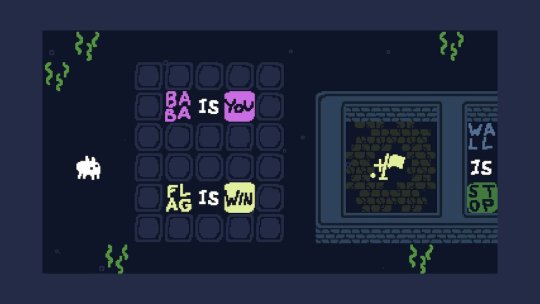
7. Baba Is You (Switch, PC)
Sokoban meets coding logic; Baba Is You layers these puzzling elements to create something that feels familiar, yet fresh. It’s a simple concept: You push physical words around the self-contained areas to manipulate the level’s rules and collect a flag…or a different win condition if you’re clever enough.
Take the screenshot above for instance. “Baba is You” means you control Baba. “Flag is Win” means you need to touch the flag to win. But say you push the words “is Win” to vertically align with “Baba.” Now Baba is both you, the player and also the win condition, so you can forget the flag. You win automatically!
The puzzles continue in that fashion, ramping up the challenge very quickly (or maybe I’m just not very good at it.) I’m nowhere near mastering it, but for its highly inventive mix of environmental and logic problems, I’ve got an incredible amount of respect for it.

6. Assemble With Care (Apple Arcade)
I’m kind of down on Apple Arcade as a concept (I’d rather just pay for the few games I want and be done with it), but if games like Assemble With Care keep coming out, I might have to soften my stance. Assemble sees you repairing broken objects like rotary phones, cassette players and watches by using the touchscreen to pull objects apart, replace their busted components and piece them back together. It’s wonderfully serene: There’s no time limit, no logic-defying puzzle box qualities, no Operation-style buzzer if and when you make a mistake. It’s just nice.
A lesser game would leave it at that, but Assemble goes a step further, wrapping the repair mechanics with a short, satisfying story with solid writing and voice acting. It’s this year’s Florence, and while it may not be as impactful as that game, it’s a must play for anyone with an Apple Arcade subscription (or a good reason to burn your free trial if you’re not a subscriber).
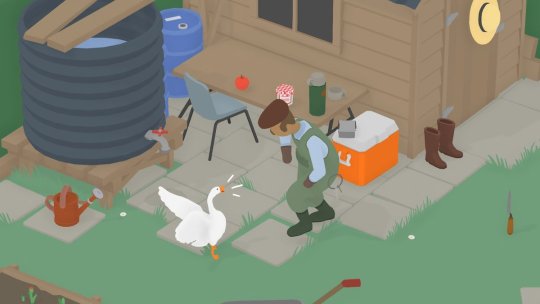
5. Untitled Goose Game (Switch, PS4, Xbox One, PC)
Like Assemble With Care, Untitled Goose Game does not hang its hat so much on its mechanics as what it chooses to do with them. There are no fail conditions to Goose Game and what challenge it holds is relatively minimal. But it’s a true sandbox game in that it’s loaded the small town you inhabit with lots of little things to play with and discover. It’s Grand Theft Auto, except they’ve replaced carjacking and shooting with taking an old man’s stool or honking at a kid until he hides inside a phone booth. You’re an asshole, you’re just not a malicious asshole.
A list of tasks helps to keep you focused, but it’s more of a nudge in the right direction so you can discover something else to mess with or people to bother. And once the game is “over,” you get a new, more inventive list of tasks, all with the benefit of the entire sandbox available to you. It might not be the most complex game, but when it comes to the enjoyment of play, it’s one of the best this year.

4. The Legend of Zelda: Link’s Awakening (Switch)
I’m well known for my aversion to finishing Zelda games. I’ve played almost all of them and have finished exactly two of them (Oracle of Seasons and A Link Between Worlds, probably not the two you’d expect). And despite enjoying it, even the original Link’s Awakening eluded me, so seeing it get an overhaul in the form of a Switch version excited me. Not only was this a second chance for me to play a classic, but it was also another opportunity for the world to see how great handheld games have always been.
Outside of the really well done tilt-shifted graphics, the remake is mostly made up of small quality of life improvements. The overworld isn’t as rigidly screen-based anymore, allowing the player a little more finesse in dealing with enemies. Some equipment, that on the original Game Boy version must be switched in and out ad nauseam, now has dedicated buttons on the controller (never again must you be without your sword). All these decisions allow for the charm of the design to shine through even easier than its original version.
Would it be nice if the frame rate were more consistent? Sure. Is the Chamber Dungeon a completely extraneous and half-baked idea? Totally. Does it tarnish the fun that’s there to be had here? Not in the slightest.
I’m proud to say Link’s Awakening has joined the pantheon of Zelda games I’ve actually finished. Now maybe someday I’ll finish that “Link to the Past” that everyone keeps talking about…
youtube
3. Super Robot Wars T (Switch, PS4)
Super Robot Wars X made my list last year despite me having only played the PS4 version. So it feels a little more legitimate to have played the Switch version of Super Robot Wars T this year. It’s still not available in the US (you have to import a copy of the Asia version that comes with English subtitles,) and it’s still an extremely flawed game with its repetitive and uninspired level design and overly complicated systems, but man, I love this bad game so much.
I love tinkering in T’s dense mechanics, upgrading my anime mechs for perfect turn-based strategy synergy. I love jumping through hoops to find the right way to recruit new units. And I still love the over the top battle animations – seriously, if you’re bitching about Pokemon’s weak animations, the video above will show you Super Robot Wars has your back.
Plus they’ve added Spike Spiegel from Cowboy Bebop this time around, so there’s at least one recognizable character from a non-Gundam anime you’ve probably seen in here. That’s…progress.
Look, this game probably isn’t for you, but it is totally for me. And Christmas came early this year in that Super Robot Wars V (which came before last year’s X – the naming conventions are not here to make sense) got ported to the Switch, and last year’s Super Robot Wars X will get ported soon too. That’s a lot of anime turn-based strategy to play, and I couldn’t be happier.

2. Pokemon Sword/Shield (Switch)
After much Internet handwringing from an extremely vocal minority, the new Pokemon games came out. And, what do you know, they’re good. Really good. They continue the slow evolution (I’m so sorry) of the franchise with small quality of life enhancements, a few new features and a little trimming of the vestiges. I appreciate the renewed focus on gyms and gym leaders and the single connected world, even if it basically two circles with a straight bit in the middle.
The new Pokemon are…fine. Very few that I detest, but also very few that I’d be willing to write home about. The new Max Raid Battles are generally pretty cool, but they all take advantage of the gimmick I’m least thrilled about: Dynamaxing. Making a Pokemon bigger for three turns is not all that compelling to me. And the Gigantamax variants with their special appearances are neat, but it’s basically just a worse form of Mega Evolution.
So yeah, it’s a good entry in the series. And a good Pokemon game is pretty hard to top in my book.
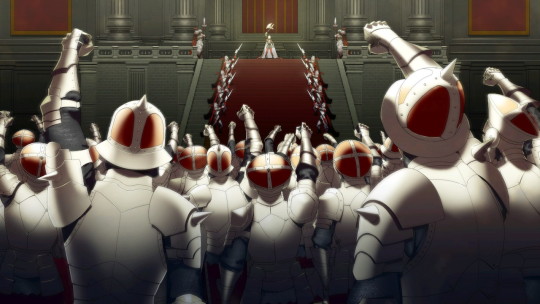
1. Fire Emblem Three Houses (Switch)
Hard to top, that is, unless you’re Fire Emblem. But despite being a new game in my favorite franchise, I was actually dreading Three Houses. The pre-release coverage did not leave me optimistic. Old features I hated were making a comeback (cough, weapon durability, cough). The art style couldn’t hold a candle to the jaw-droppingly gorgeous previous entry, Fire Emblem Echoes: Shadows of Valentia. And whether Intelligent Systems was admitting it or not, there was a strong Persona-fication at play here (don’t get me wrong, I love Persona, but if you’re going to get your Persona chocolate in my Fire Emblem peanut butter, I’d rather you just make a sequel to Tokyo Mirage Sessions #FE.)
So the hopes, they were not high. But Three Houses exceeded my expectations with a cast of characters I really grew to love. My loveable loser Golden Deer crew went from zeroes to heroes, and the ability to recruit students from other classes meant I got to make my dream team (Hilda, Petra, and Lysithea were my undisputed MVPs) when saving the world.
The story was deep and complex, and hearing how it changes based on which house you align with is pretty cool. I enjoyed the control I had in molding my students, and appreciated seeing them have a breakthrough in something they used to struggle with, and it becoming one of their best qualities. Turning a lazy, valley girl like Hilda into a front line tank and hearing her bitching about it every step of the way was especially enjoyable.
It’s not my favorite in the series, but I’m glad it’s seen pretty universal appeal and sales from the community at large, cementing its status as one of Nintendo’s premier franchises. Someday I will play through all four of its routes, but for now, I’m content with it comfortably sitting as my favorite handheld game of 2019.
#goty#gotggoty2019#chase koeneke#tetris 99#mini motorways#risk of rain 2#baba is you#assemble with care#untitled goose game#the legend of zelda link's awakening#link's awakening#super robot wars t#pokemon sword#pokemon shield#Fire Emblem Three Houses
2 notes
·
View notes
Text
Interview with the Holo team on distributed system…
Interview with the Holo team on distributed system…
Decentralized systems, such as blockchains, are enabling new systems that would previously have been impossible.
The following interview focuses on the radical potential of distributed systems, transcribed from a chat room for Holo, the creator of Holochains.
Holochains may prove suitable for replacing platforms such as Facebook, AirBnB, and Uber in the future with new structures that share wealth transparently if not equitably.
For a general interview of Holo and what it makes possible, read my previous article.
For a seeking a more technical overview, check out Moritz’s article.
* * *
TRISTAN ROBERTS: Who are you, and how did you get involved with Holo?
EMALINE FRIEDMAN: I’m passionate about the link between human dignity and the dream of post-capitalist social arrangements. I was working on a doctorate in Psychology, a critical perspective on “Internet Addiction”, when I got involved with Holo. I realized that the suffering caused by our Internet dependence has a lot more to do with the economics arrangements and power asymmetries in the digital world, so it didn’t take long for me to see that I had found the right project.
JEAN RUSSELL: I have a passion for group and collective productivity. Since 2007, I have been championing “Thrivability” as an aspiration, which is our collective generativity. My latest book on the topic is Cultivating Flows: How Ideas Become Thriving Organizations. Arthur invited me in to be “outcome oriented” back August 2017. I have been playing with Art, Eric, and Ferananda on projects since 2005. It fits as the next step in work I had been doing with Kaliya, aka Identity Woman, on Personal Data Ecosystem Consortium and some of her other efforts.
TRISTAN: Emaline, you mentioned that you’re excited about shifting the “economics arrangements and power asymmetries” currently embedded into the internet. Can you perhaps define the entities or trends that are emerging, and broach why you feel Holo is particularly suited to empowering these shifts?
EMALINE: I’m talking straight, unbridled capitalism-as-usual, online. People often complain about ads being annoying, and yet that’s just a superficial reminder that we spend most of our digital lives on someone else’s platform–companies that don’t necessarily have our best interests in mind.
Our attention is captured for the express purpose of generating user data for which there’s a massive market of actors who can use it to better structure our world, so to me the Cambridge Analytica stuff is pretty much just business as usual. I think that with enough awareness of the business model of the net folks will want to start reclaiming it by dissolving it into many distinct public spaces. Of course, this has to start at the infrastructural level… that’s Holo all over. Cooperatively owned and operated platforms are an absolute must to do any bottom-up organizing.
* * *
TRISTAN: Holochain describes itself as being agent-centric – why is this important?
EMALINE: Agent-centrism is a term we use to mark the way that Holochain’s approach is distinct from the data-centrism of most computational models. Technically speaking, agent-centrism describes the fact that each Holochain node is responsible for keeping track of its own history and the little fragment of gossip that it propagates in a given community.
I specifically appreciate that that model is more similar to our physical bodies–how they are ultimately a collection of historical traces and things we’ve lived across time. Contrast this with the data-centrism of our current Internet, or blockchain, where data rather than people are taken as the unit to be watchful of. In both instances instead of a person applying this watchfulness to him or herself (including how they play roles in communities), some actor, either every node on the network, or a global company, portends to a god’s eye view of the whole.
Art Brock talks about this as bringing computing up to speed with the theory of relativity, but to me this is aligning computing with the feminist critiques of science that have also been around for decades. The message of the feminist critics is one that Holochain most definitely enacts: when everyone is willing to embody or otherwise take responsibility for their unique perspectives, we get a system where people can pursue their own paths with far greater equality (and in the case of computing, incidentally, greater efficiency).
JEAN: For me this is the natural evolution from a critique of objective reality… some sort of data truth to out at the center. Of course there isn’t a single truth. Most of the time that is a really magnificent thing. Shifting from the data to the perspective on the data means we can have a multiplicity of truths. More than that, the work of centering and reconciling data in a decentralized but data centric world is computationally costly. Shifting to agent centric makes it so that only nodes that touch have to reconcile their views of reality and only where that matters (accounting but not on breakfast).
TRISTAN: The internet has certainly enabled a multiplicity of perspectives that would be hardly imaginable in the days when newspapers and T.V. broadcasts reigned as our information ‘feed’. But this multiplicity that Web 2.0 offers seems dampened by the intentions of content-aggregators that design our feeds. Do you think distributed platforms will allow us to better separate the signal from the noise?
JEAN: So far this has been quite a game. You develop tools to reduce noise and marketing people are very clever about coming up with new creative ways to work around those filters. Beyond that, what is noise to one is music to another. FB and Twitter are not useful at full throttle if not carefully managed. My hope is that we keep putting the choice in the hands of people for how to filter instead of letting a company do it. Filtering is imperative. Who, how, we filter matters. I hope distributed solutions provide ways to filter (and filters we can share, so the admin load is lighter). However, it might be a never ending game to navigate.
TRISTAN: What are some ways in which identity is evolving through Holo/agent-centrism?
EMALINE: So, identity is everything that we say we are. I’m a huge proponent of psychoanalytic thought, so to me there’s a glaring gap between what we say we are and the things we actually end up doing and saying. Provided that the immutable self-records on which Holochains rely count as legitimate evidence in communities of practice, one has a much greater ability to match their self-image with their collected history. This has huge implications for identity and for something a little more spiritual.
On the one hand one has the opportunity to advocate better for oneself, to repudiate false claims, to compile trustworthy resumés related to very specific activities, and to bust out of the current web’s model (in which people’s information gets used against them, ironically, because it’s not collected well enough, but by tons of different companies and data brokers who can only but piece things together quite shoddily).
On the other hand, agent-centrism amplifies the struggles and joys of being human… there’s no telling what sorts of things can be achieved with the power of a self-owned, more accurate record. It’s like, you may have a lot more awareness of how much you lie to yourself about your online habits (of shopping, chatting incessantly, whatever), and more awareness that you’re actually more charitable or more spend-happy than you give yourself credit for. What people do with this such awareness (think Oedipus and the oracle at Delphi) is more profound than identity. It’s right where popular modernity meets a sort of tragic, beautiful spiritual growth process.
JEAN: Again, Emaline has wonderful words here and in her article [on ‘Distributed Public Key Infrastructures‘] she did for [the series] the Holochats I started on Identity.
I have a strong attachment to identity discussions on numerous levels. I will try to be brief.
identity is how we perceive ourselves AND how others see us as well as the situation we find ourselves embedded in, including which “publics” are watching.
coding the real complexity of how identity works is quite a challenge.
Imagine if your only experiences of the world were from films: you see what the director allows you to see – a single truth. And then suddenly you have a world where everyone is using their phones to record and share video – the many perspectives available. The difference is huge and yet oddly unspeakable. Same world. Vastly different experience.
TRISTAN: I want to touch on the spiritual side of identity. While idealistic groups have been working on crypto platforms for decades, it seems exceptionally rare for these systems to gain much of a network effect (Bitcoin and Ethereum being notable exceptions). What will it mean for humanity if and when these self-sovereign systems can start to interact fluidly with each other?
JEAN: I don’t know what it might mean for humanity if these systems become interoperable. Identity is one of those worldview concepts that it is difficult to see outside. Some say in Shakespeare’s time, authorship didn’t mean what it does today. And they suggest Shakespeare is an amalgam of a whole troupe of actors together. We have lived in a time with a cult of individuality, especially in the US. And yet depression, often from loneliness and a lack of belonging, is the consequence.
My hope is that this self-sovereign systems help us be both our own identity and a part of something larger in ways that we can feel our agency and yet belong and connect. I believe that both-and possibility is a healthier and more enlivening world.
* * *
TRISTAN: How do you think of the relation between humans and technology, and what is your perspective on how this is evolving? Do you see an end goal, or at least, a next stage?
JEAN: We have so many stories of man against machine or man against nature. Robots helping free us from jobs becomes robots taking our jobs. I am curious how we can have technology support us in being more human.
How can we use technology for what it excels at: repetition, logic, data storage for example? And how can that help humans be more creative, playful, recreational, and connected? There are many ways in which social media enabled us to be more human together. But with the Cambridge Analytics story unfolding, human fallibility is center stage too. How can we keep steering through the tensions toward humans being better humans together, because isn’t that what this is all about?
Next stage: yes, specifically I have thought about applications on Holochain that help me be more human such as managing my personal health data making it more portable and easier for me to give a new doctor permissioned access and also giving them information from my Fitbit or other tracking tools. When the system is agent centric, this is way more human of a process instead of bureaucracy that is a time suck and dehumanizing.
EMALINE: I’d say that growing pains mediate the relationship between humans and technology. How each person deals with the part of them that wants to be able to do more, extend their senses, etc. is the difference between the frustration and feeling of exclusion for many, recoiling altogether, or the polar opposite, a kind of hypnotized, “more, more!” attitude that denies all other considerations (eating, sleeping, boring human stuff).
This is the philosophical nature of the beast, so for me this hasn’t evolved much at all. What’s interesting about Internet tech, though, is that it involves the part of us that wants to be with and learn from others more intensively. At a societal level, though, this pits us with the question of who we want to be exposed/expose ourselves to, when, and for what reasons. I certainly hope, like I mentioned, that we become more aware of this, and wise about grouping ourselves for ourselves. There’s power in numbers, and so these coordinative efforts, whether from above or below, will be determinative of where and how we live, and what we live for.
It’s all very political, and as always, freedom of association is key. This is what I hope Holochain makes easier…the freedom to find one’s pack, so to speak, through the micro-cultural stuff–community rules and norms that are livable and sensible rather than super oppressive and kafka-esque.
TRISTAN: Many upstart projects promote themselves as being decentralized but fail to live up to that term when real money and power become involved. Holo is open about being a fairly a centralized corporation that is in the midst of distributing its power. Could you comment on if and how you’ve been experiencing this process, and speak to the peer-to-peer community on any lessons learned?
JEAN: First, let’s look at the layers at which we might be speaking here. Is the team decentralized at an infrastructure level? Is authority decentralized within the team on the project? Is the economic engine of the project decentralizing or centralizing? What is the trajectory for those things? Are they different between Holo and Holochain?
The Holo and Holochain team (pretty much same humans) are physically decentralized — as in work on this project has occurred on 6 different continents. We have never yet all been in the same room at the same time!
Is authority decentralized? Sort of. We came together held by a vision asserted by a few and money is handles and allocated by a few. However, work is organized by something of a do-acracy and major decisions are conducted as a “sense of the meeting” with everyone providing input.
Is the economic engine a decentralizing pattern? Well, yes. First, Holochain is open source. Holo is a hybrid with a bridge back to the more centralized web and as such it is also more centralized financially, for now. We worked hard to make sure that whales could not come in to offset the balance of community decision-making and intend for Holo to evolve into a community-managed (or at least heavily influencing) organization. We continue to navigate the finance and community governance toward decentralized approaches. We want this to be a P2P Sharing Application AND a model for more such applications to come. Our job is to make each run well and then build the next. Personally, I think power is a great thing as long as it keeps moving around and doesn’t become static. When it stagnates, it corrupts.
I think I addressed that it is different between the projects: one being more centralized with money flowing through and the other being open source with no native currency.
We are in the early days of the next evolution in distributed coordination of humans. Lessons? Mind the tensions between how vastly different humans can be, how (overly) simplifying protocols can be, and the administrative time of being clear and aligned together. Personally I would add that the Quaker practice of sense-of-the-meeting is so much better than consensus. It reminds me of Brian at Holocracy talking about everyone being a sensory input for the whole.
EMALINE: I’ll leave it at Jean’s beautifully laid out answer. Especially because we haven’t really started distributing our power yet =P
* * *
TRISTAN: A lot of people can get a vague sense that distributed, self-sovereign systems are going to positively impact their lives, but it seems a mystery as to how that might unfold. Can you speak on how you see this core foundation being developed?
EMALINE: Agreed… it’s not easy to envision, and is further complicated by the fact that we’ve always been super careful not to make egregious promises. The core foundations of the positive impacts of distributed systems is the necessity of explicit rules exercised in a programmatic way.
I think that when it’s clear what criteria different communities use to make decisions it becomes easier to feel comfortable jumping in fully or to avoid a lot of heartbreak from the outset owing to expectations that are clearly discordant with people’s MO’s. There’s a lot of fear around identity and reputation systems, but when they’re self-managed and used for opting in, one can more easily set reasonable goals, improve or choose to disavow particular reputation parameters, etc.
Given what I’ve said about data scraping as, essentially, unrecognized labor, just the idea of recognizing and accounting for various contributions, on and offline, is exciting. The key is that the people know the purposes for which their identity components are under scrutiny. This is better for decision-making, better for acceptance, better for awareness of context, and is a lot easier to achieve through a distributed accounting/computing system.
TRISTAN: Presently Holo’s most built out apps, if I’m not mistaken, are a Slack and a Twitter clone. These are great examples of structures previously only viable on a fairly centralized system. But it doesn’t feel like they have shown the “value add” of a distributed system. Are you using any Holo apps yet regularly? Or for which ‘killer apps’ are you most eager?
EMALINE: Yep, they haven’t… and I think that owes more to the fact that we’ve done nothing to encourage adoption (except using the Twitter clone at hackathons, and the Slack one internally). I’m interested in the possibility for distributed social media to enable user-selected pooling of psychological/behavioral data for profit or by donation to research initiatives and planning causes they care about personally.
Anyway though… not yet using Holo apps. So very looking forward to rejoining my community in Atlanta and co-creating a community currency/skillshare accounting engine. Have also lately been dreaming about an app that evenly distributes grant, crowd, public, or private investment funds to individuals jointly contributing cognitive labor to particular research projects. And of course some decent rideshare apps, dear god.
TRISTAN: Ahh thanks for getting back into tangible use cases for building local community. It’s easy to get disconnected in the heady thoughtspace of distributed peer-to-peer systems. Assume the maturation of the Holochain eco-system. How would you like to bring these systems into your ‘real’ or virtual life, Jean?
JEAN: I have three personal aspirations with Holochain and Holo. First I have wanted a real Peers Inc (Robin Chase) platform for us to cooperate on access to goods and services together. Holo is the first application we have for this, and I want to help create more through our Commons Engine. Second, I would like to support Cameron Burgess and his team on Billions to Trillions with their model for using markets running on Holochain to address the wicked problems in the world. And thirdly, for myself, I want a personal assistant application that keeps my health data and calendar etc but runs A.I. over it to help me be better at being me, a sort of quantified self plus secretary running off smart data.
TRISTAN: Personal assistant A.I.’s that aren’t just trying to sell you stuff while selling your information are one point I’m exceptionally excited for as well. Decentralized big data and algorithm markets like SingularityNet and Oceans might make this happen sooner than we’d think. I’d love to go further, especially on this topic of personal assistance but I imagine you two are both super busy during Holo’s initial community offering.
JEAN: This has been super fun as a way to do an interview! Thank you Tristan. I really enjoyed the weave with Emaline too!
EMALINE: I completely feel that– I’m actually impressed that we’ve gone this far. It’s been really fun reflecting in this way during ICO madness, so thanks Tristan and Jean.
Featured image from Chester Alvarez on Unsplash
La entrada Interview with the Holo team on distributed system… aparece primero en Crypto Insider.
Source
The post Interview with the Holo team on distributed system… appeared first on Bitcoin Geek.
via Kingmind Interview with the Holo team on distributed system…
0 notes
Text
Post P. Evaluation
1. What were the aims of your artefact?
As I stated in my post A. Brief, my initial aims of my artefact was to make a coming of age / romance film which is about losing a relationship with someone such as family member, friend, or lover because it is one of the most common hardships that people go through in their lives and therefore everyone can empathize with it. My textual analysis was about two American teen movies, The Fault in Our Stars (Boone, 2014) and The Spectacular Now (Ponsoldt, 2013), and they are both about adversities that the characters get to face as adolescents and how they deal with those problems.
What I wanted to make at the very beginning even before I started the planning part was quite different from the final result of my short film. The storyline I firstly came up with was much more concentrated on romantic aspect rather than a theme of coming of age. It was about a young man who lost his girlfriend as she struggled with depression and eventually took her own life and I wanted to present not only feelings of grief and despair of the boy character but also nostalgic memories between the two in very emotional way to imply how fragile and vulnerable teenagers can be when they are exposed to intense emotions as they don’t have much experience of them. However, since the purpose of my textual analysis was to explain how the theme of coming of age is portrayed in the two movies as unconventional teen films, I thought my own short film should also be more focused on unconventional factors to follow the textual analysis. Thus the storyline has changed after the planning started and the the new theme that I conceived was a domestic abuse and the consequential mental health issue of the children. It’s so often for us not to be aware of as an observer when teenagers around us are suffering from domestic violence, because unlike young children, they know how to hide it from other people’s eyes. They tend to recognize the fact as their dirty laundry revealing that they are not like other ‘normal’ people so most of them don’t easily let others know their current situation. The message that I hoped to convey through my short film was that all is not as it seems, people always could have problems that we don’t see but still is desperate to be helped.
2. What codes and conventions identified in the TA were used in your film?
Genre
The main genre of the two films I’ve studied in my Textual Analysis was romance and drama and therefore I had focused on romance genre during the planning as it’s shown in my post E. Genre research. However, after I decided to change the story line the genre of the film became quite vague and eventually it got closer to hybrid of drama and slightly crime/thriller rather than romance. The first half of the film is shot by fully handheld camera showing the protagonist and the voice-over telling the story of him is overlapped on it, which present very dramatic tone overall. The second half includes more aspects of iconography from thriller genre, for instance flicker effects and deep and dark tone of non-diegetic sounds. Nevertheless, there still were some romantic conventions left in the film as the two main characters were connected by the romantic relationship between them. Some of the lines of voice-over are obviously revealing affectionate feelings of them two with conventional lexis uses.
Cinematography
As the one thing that I’d wanted the most while directing the film was not to duplicate the two films of my TA, I intentionally tried not to follow the exact cinematographic effects of the originals especially stylistic ones, but rather apply some of the very basic techniques. The cinematographic technique that I thought was the most important for the first half of my short film was to frame enough medium shots. Just like I mentioned above, the first half was meant to be very realistic and natural, so I shot all of the scenes with a handheld camera using medium shots so that the audiences could feel like they are looking at the protagonist right next to him, as if they’re actually with him.

Example of medium shot from <The Fault in Our Stars>

Example of medium shot from <Ripped>
Another technique which was very significantly used in my film influenced by my TA is low key lighting. During the second half of the film, the overall mood totally changes and it gets way darker than the first half. Even the genre seems to change after the bridge, from drama to thriller and I thought that the best way, also the most basic way to present the mood changing visually was to dim the light which was used in the chosen sequence of <The Spectacular Now> as well.
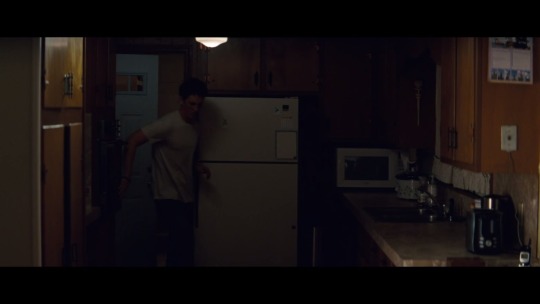
Example of low key lighting from <The Spectacular Now>

Example of low key lighting from <Ripped>
The last aspect of cinematography influenced by my TA is half face shadow. It is very commonly used when the character is struggling with an inner conflict and having a hard time in his mind. In the relevant scene from my short film, the protagonist is being mentally unstable at the moment and lost himself between his original personality and the hyperemotional one.Therefore I thought the half face shadow could successfully reveal his hidden instability as he is a type of character who never shows his inside.
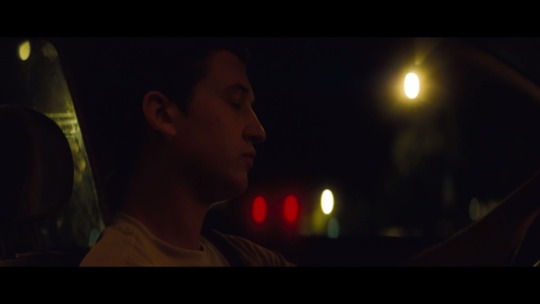
Example of half face shadow from <The Spectacular Now>

Example of half face shadow from <Ripped>
Mise en scene
Just as I did in cinematographic aspect, I mainly aspired to get only basic ideas from my TA for the Mise en scene as well. One thing I derived from <The Fault in Our Star> was how to use costume in a way to explain the character’s mental and social status. While in the chosen sequence of <The Fault in Our Star> Hazel wears hoody, jacket and jeans and Augustus wears sweat shirt and sweat pants which tells that how vulnerable Augustus got both mentally, physically and socially compared to Hazel, in <Ripped> the protagonist wears a costume of jacket, dress slacks and hat which obviously shows stiffness and formality of his personality, also that he is originally from quite wealthy background. It is quite significant indicator as Julian is a character who had been exposed to domestic violence for a long period of time but couldn’t get away by accusing it as he shouldn’t disgraced on his family. And the fact that he still wears what he used to wear presents that he is still under the control of his past memories and traumas.
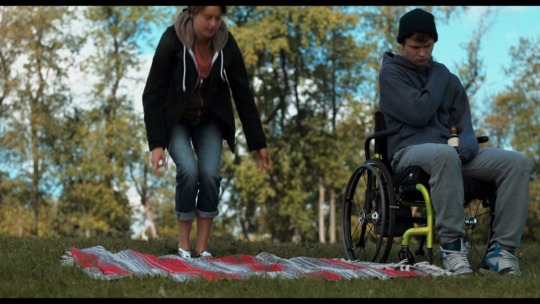
Example of the use of costume from <The Fault in Our Star>
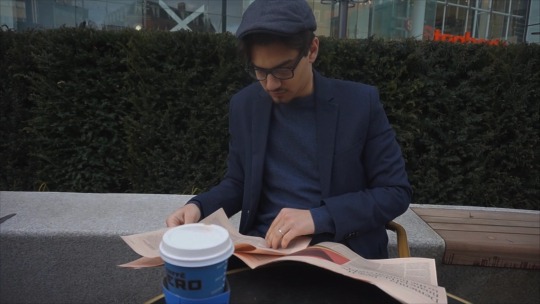
Example of the use of costume from <Ripped>
Sound
In both of the chosen sequences, soundtracks take a big part of indicating a change of the mood and tone of the scene. They both starts with background musics that clearly contain sad and gloomy atmosphere and ends with much more hopeful and delightful musics that change the mood brighter. In my short film, soundtrack is also used as a very important tool of tone changing. I chose quite relaxing but delicate and mournful song for the first half as Effie talks about the memories of her and Julian in a nostalgic way. For the second half, I inserted more heavy and majestic song to give the image of seriousness and more tension in the scene, so that it can be distinct from the former scenes.
Editing
I haven’t really used any kind of editing skill that is considerably stylistic or unique, it’s mainly just cuts as it’s the most basic way of editing and my TA sequences also use basic cuts between every shot. I think what makes my artefact different from the two sequences is a dissolve transition used consecutively in the middle of the film. The technique was very useful to make the scene look mysterious as the successive dissolved moments convey the image of a defective memory.
3. How were the planning materials used in the construction of the artefact?
The reason why I chose <The Fault in Our Star> and <The Spectacular Now> for my TA essay at the beginning was simply because they were the most touching coming of age films in my personal opinion. However after I watched them several times for the essay, I found out that the biggest common feature between them was that they are portraying teenagers in very honest and completely unrefined way. There are so many teen romance films out there and quite a lot of them is not that same with the reality. In these two films, teenagers are exhibited as very unstable, incomplete and fragile creature while they commonly get presented almost like adults in other films. The characters in those two films show us their negativity caused by things like short lifetime or lack of experiences and knowledge throughout the whole film and that makes teen audiences genuinely feel like it’s exactly what they are suffering from as well. I started to establish my planning based on that idea. I wanted to make a movie showing a problem that people don’t like to talk about or don’t recognize that easily but is still existing. That is how I came up with the subject of domestic abuse and teenager’s mental health issues caused by it.
In my case, the most important piece of planning when it came to the filming process was the audience feedback. This was the first time I made a film in my lifetime and therefore I was completely unsure about whether what I did was right or wrong. After I screened my rough edit version in the class so many helpful feedback telling me the points that I haven’t noticed at all and loads of them also lifted my confidence with such kind words. I think it was very significant process especially for students like me, who don’t have much experiences of film making.
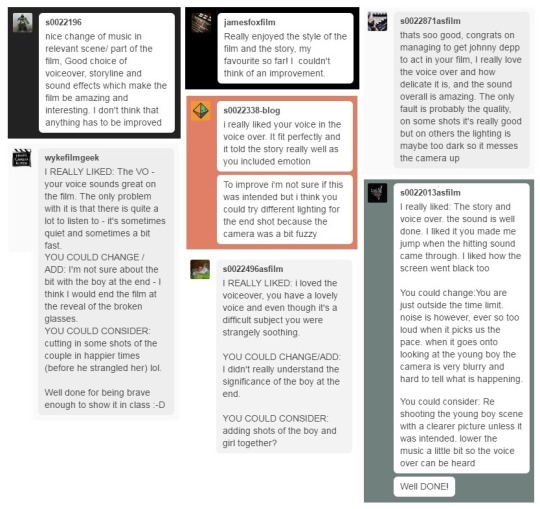
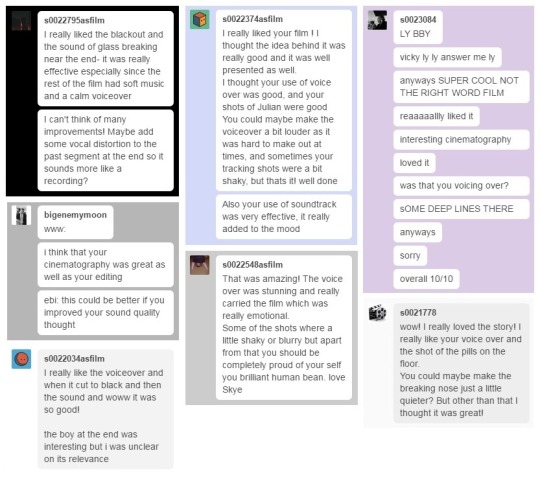
Audience feedback
I don’t specifically think I needed to do more planning to be honest, of course planning is important as it’s a foundation of the film but I don’t regret that I put much more time in actual filming and editing because my plans did change quite a lot after that. When I started planning of the film, I had so many ideas and thoughts that were practically not a possible options. It’s always so different from what you think it would be like when you actually try to put your thoughts into the practice. The first thing I had to modify was who I will have as actors of my film. At the beginning I had two of my friends who was meant to act a female protagonist and male protagonist but as the former one moved out to different place after the plan was made, so I decided to change the story line a bit rather than get a new actor because I thought the new story would fit the aim of my filming better anyway as I stated at Q1. Even after that, I had a number of modifications such as deleting a whole scene, changing locations, replacing props, delaying shooting schedule, and so on. Overall I’m quite satisfied with the final result I’ve got, but still think I can produce a better outcome if I get a chance to try it again next time.
4. How successful was the artefact in achieving the aims?
I can’t say that I’ve done 100% of what I wanted to do, but think the result seems to be better than my concern and is conveying the messages I wished to say quite obviously, both for my TA and the short film. Nevertheless, if you ask me whether I want to get a chance to start again completely or not, the answer would be definite yes. Since it was the first time ever I made a film, there were things that I forgot to care about although they really do matter to me, for instance the overall color tone match and the video quality. If I get a chance to start over, I would use a camera with a higher performance to shoot and edit more elaborately, putting more effort into color compensation. I also should’ve talked to my actor more about the character so that he could lend more probability to his acting. One of the things that I feel upset the most about my film is the deleted scene of young Julian. Since I had to delete it because of the time limit and video quality problem although it was a key scene directly exhibiting how Julian got dissociative identity disorder, I’m not entirely sure that all of the audience would understand the narrative clearly without it. The young actor who played the role was such a brilliant kid and I genuinely think it could’ve gone really well if I had enough time to reshoot the scene a couple more times.
0 notes